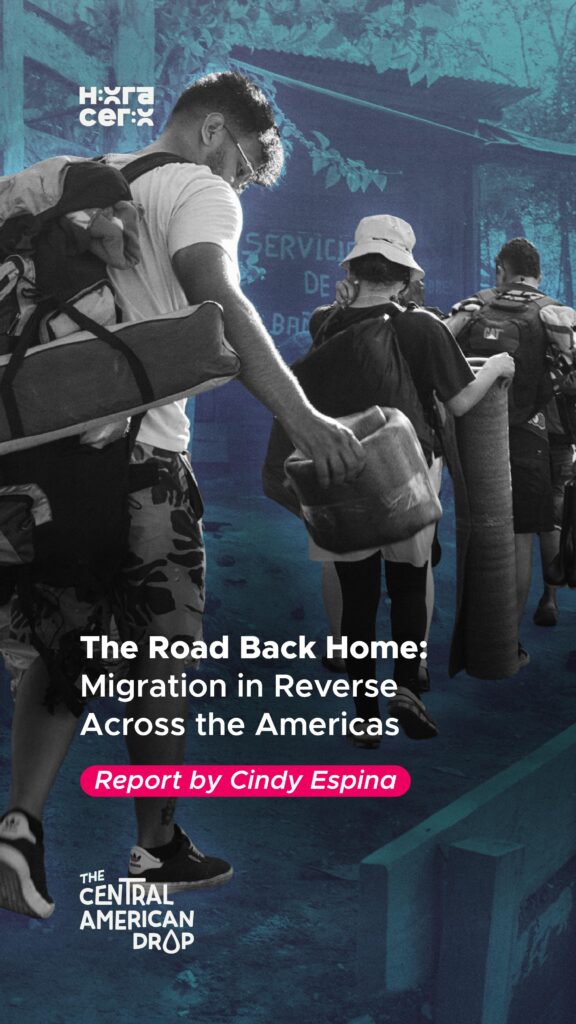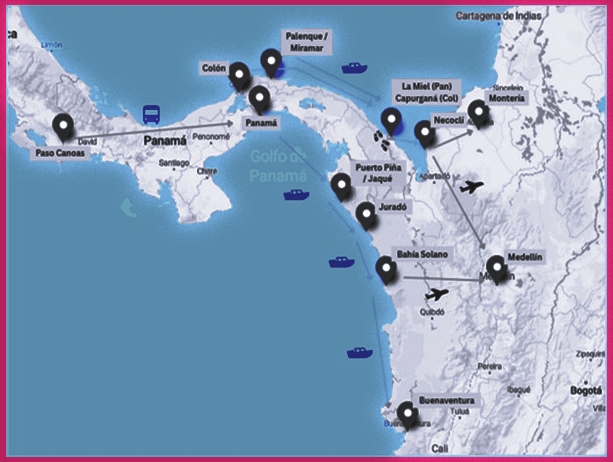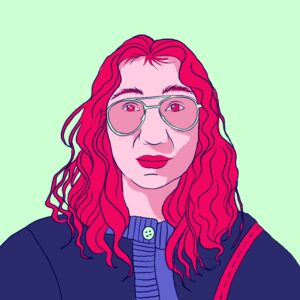
«Now I only ask you, God, to allow my wife and me to arrive safely at our destination, and God, also give strength to my fellow countrymen on the way, that they may also reach their destination, Amen.» This was part of the message Samuel posted on his social media to say goodbye to Mexico and thank all the people who had supported him there. He then posted a video in which he commented that he was in Tapachula, Chiapas, where he announced that he was on his way to Venezuela by land. Although he tried to get his passport at the Venezuelan embassy, they simply couldn’t resolve the process, and therefore, he couldn’t fly back down to Venezuela.
The report entitled: Reverse Migration on the Costa Rica-Panama-Colombia Route prepared by the human rights defense offices of those three countries, reports that, from January to August 2025, 14 thousand people have made a “reverse migration” from north to south. According to human rights defenders in all three countries, this was caused by the tightening of the United States’ «immigration policies». This new political landscape, in addition to the suspension of cooperation funds, generated a more serious situation since humanitarian assistance and the possibilities of protecting migration routes were reduced.
In Samuel’s responses to his followers on his account about why he returned to Venezuela, the young man says his motivation for returning is that he missed his country. «How are you doing, my people? We’re here in Barquisimeto, my people.» In Venezuela… «Dad is receiving us. I am here with my wife. Thank God in my land,» were the words Samuel recorded on September 9, 13 days after leaving Mexico City to complete his reverse migration process.
In the video, he was seen smiling, conveying only tranquility and satisfaction, alongside his father, who took the opportunity to greet Samuel’s followers. A few hours after that post, the young man with 9,789 followers spoke with Hora Cero via WhatsApp messages. In this conversation, via text messages and voice notes, Samuel said he was very happy to be back in Venezuela. That same evening, a new video confirmed his return: in the images, he was seen supporting the «vinotinto,» the Venezuelan national soccer team, in a qualifying match for the 2026 World Cup. He reiterated his faith, and he did so from his parents’ home in his homeland.
@sam_josue1 Apoyando a nuestra vinotinto, tengo fe mano, tengo fe... #venezuela🇻🇪 #parati #eeuu #barquisimeto #vinotinto ♬ sonido original - Samuel Josue
Despite the sincerity and longing for his homeland that Samuel conveys in his videos, this is not the reality for all the people undergoing this reverse migration. Human rights defenders from Costa Rica, Panama and Colombia captured the direct testimony of some182 migrants who made the reverse transition like Samuel and in this process of capturing stories, 49% of people said that the main reasons for their return were due to the impossibility of entering the United States, 46% said that this was combined with the change in immigration policy, 17% of those surveyed said it was due to fear of detention and deportation, 27% added that it was due to immigration insecurities, and 4% mentioned that it was due to lack of access to assistance and protection services during transit.
The report notes that, despite all the reasons, return decisions do not occur voluntarily, but rather are the result of deterrence, coercion, and the lack of protection guarantees for migrants and refugees in transit and destination countries.
For its part, Doctors Without Borders (MSF) notes in its report, Rejected: The devastating human impact of immigration policy changes in the United States, Mexico, and Central America, that migrants are forced to return after being criminalized, persecuted, or hampered while traveling north, but receive little to no support on their return journey. MSF believes this leaves already vulnerable people without resources or protection and further exposes them to criminal groups and greater risk upon return.
Meanwhile, Samuel Josue continues to share details on his TikTok account about the costs, times, and locations for this return, as many people tell him they are interested in making this reverse migration by land and need this type of information to prepare.

Reverse migration is fraught with a lack of information and protection. In the three countries where the report was conducted, the constant is the absence of authorities to guarantee protection and a lack of personnel to support this process.
In Costa Rica, the Ombudsman’s Office found that the Temporary Care Center for Migrants (CATEM Sur) does not function as a shelter for the population mobilizing to return, because it has not received any individuals with this profile. Furthermore, they do not provide information about the possibility of receiving protection status in the Central American country.
In Panama, the Ombudsman’s Office found that maritime transfers from Panama to Colombia are carried out without any supervision or presence of authorities, further undermining the security situation of people who are traveling.
In Colombia, the Ombudsman’s Office warns that reverse migration has exceeded local capacities, especially in coastal and border areas.

| Cookie | Duración | Descripción |
|---|---|---|
| cookielawinfo-checkbox-analytics | 11 months | This cookie is set by GDPR Cookie Consent plugin. The cookie is used to store the user consent for the cookies in the category "Analytics". |
| cookielawinfo-checkbox-functional | 11 months | The cookie is set by GDPR cookie consent to record the user consent for the cookies in the category "Functional". |
| cookielawinfo-checkbox-necessary | 11 months | This cookie is set by GDPR Cookie Consent plugin. The cookies is used to store the user consent for the cookies in the category "Necessary". |
| cookielawinfo-checkbox-others | 11 months | This cookie is set by GDPR Cookie Consent plugin. The cookie is used to store the user consent for the cookies in the category "Other. |
| cookielawinfo-checkbox-performance | 11 months | This cookie is set by GDPR Cookie Consent plugin. The cookie is used to store the user consent for the cookies in the category "Performance". |
| viewed_cookie_policy | 11 months | The cookie is set by the GDPR Cookie Consent plugin and is used to store whether or not user has consented to the use of cookies. It does not store any personal data. |